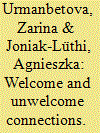|
|
|
Sort Order |
|
|
|
Items / Page
|
|
|
|
|
|
|
| Srl | Item |
| 1 |
ID:
154521


|
|
|
|
|
| Summary/Abstract |
Medical travel has become a self-evident and intrinsic part of the medical landscape in the Republic of Maldives. This article raises the question of how exactly this has emerged as part of today's reality. The analysis describes the unfolding of a pronounced Maldivian medical travel culture by focusing on a particularly pressing health issue. The population of the Maldives has to face the world's highest prevalence of beta-thalassaemia, a genetic disorder affecting the body's ability to create red blood cells. The country's 300:1 sea to land ratio, however, with its small population of 340 000 scattered over 200 islands is a challenging context for the curative and preventive measures in thalassaemia governance. The article follows the trail of thalassaemia-related intra-archipelagic and extra-archipelagic medical travel of patients and clients requesting a blood transfusion, iron monitoring, bone marrow transplantation and prenatal diagnostic services. It discusses medical travel organised as a biosocial group activity, financed by insurance and religious bodies while interacting with the migration of health professionals.
|
|
|
|
|
|
|
|
|
|
|
|
|
|
|
|
| 2 |
ID:
138253


|
|
|
|
|
| Summary/Abstract |
The 1895 Pamir Convention divided the mountainous region of Badakhshan into separate entities under Russian and British/Afghan influence, leading to a remarkable divergence in the development fortunes of a people once united by kinship. For those in today’s GornoBadakhshan in Tajikistan, incorporation into the Soviet Union brought investments in education, health, physical infrastructure, and the economy. People living in Afghanistan’s Badakhshan Province retained more political freedom but lived remotely within a feudal state where development investment was limited. In recent decades, both regions have experienced conflict that has affected their development. In this article, we use findings from quality of life assessments carried out by the Aga Khan Development Network to illustrate the stark differences between the Badakhshans. We discuss ongoing efforts to implement cross-border development programmes to improve quality of life in both Badakhshans, while noting that their success depends on a stable security environment in the region.
|
|
|
|
|
|
|
|
|
|
|
|
|
|
|
|
| 3 |
ID:
181630


|
|
|
|
|
| Summary/Abstract |
Recent years have seen a significant growth in studies of “remote” and “distanced” forms of military intervention. At present however, few analyses have sought to explore the remote character of interventions beyond Western (especially US&UK) cases despite the fact that regional powers in other parts of the world are increasingly militarily active, particularly in the Middle East. This article seeks to look beyond US and UK cases of remote warfare and explore the remote character of the interventions of Saudi Arabia and United Arab Emirates in Yemen (2015-to date). Using the notion of “practices” that emphasizes both change and continuity in the performance of remote warfare across different contexts, the article shows how Saudi and UAE remote warfare practices show variation both from the US and UK examples and from each other in terms of strategic logics, tactics and the benefits of remoteness. This focus on practices allows us to move beyond debates about what remote warfare is, and who uses it, and permits a broader discussion about change and continuity in the way remote warfare is implemented.
|
|
|
|
|
|
|
|
|
|
|
|
|
|
|
|
| 4 |
ID:
181633


|
|
|
|
|
| Summary/Abstract |
This paper aims to develop the study of remote warfare’s constitutive “remoteness.” It proposes a novel definition of remoteness as the degree of the American public’s socio-psychological detachment from the realities of political violence fought at a physical distance from the continental United States, as mediated through spectatorship of the use of military force. The remoteness of remote warfare has physical, psychological, and social properties. We argue that it exists on a continuum subject to change over time and should not be approached as a fixed condition measured solely by the physical distance separating combatants involved in armed fighting or as the use of various weapons technologies. The numerous dynamics associated with the remoteness of remote warfare are illustrated through an examination of American military intervention in Libya during Obama’s presidency. From the height of the 2011 NATO intervention in the country onwards, US military operations in Libya became more “remote” for the American public. Whilst other contextual factors contributed toward this outcome, we argue that the diminished spectacle surrounding the 2016 Operation Odyssey Lightning helps explain the American public’s increasing remoteness from military intervention in Libya.
|
|
|
|
|
|
|
|
|
|
|
|
|
|
|
|
| 5 |
ID:
185923


|
|
|
|
|
| Summary/Abstract |
In this article we discuss how infrastructural connections – here the ‘northbound’ and ‘southbound’ sections of a transregional road crossing the mountainous district of Toghuz-Toro in central Kyrgyzstan – become sites where identities can be either confirmed or contested. Linking this district with places that figure prominently in the symbolic geography of Kyrgyzstan, which divides the country into North and South, the two sections of road are inherently enmeshed in regional identity politics. Further, the article considers how the inhabitants of Toghuz-Toro take care of their own mobility and preserve desired connections in a harsh terrain, in the absence of state-managed public transport, and in a situation that sees only rudimentary road maintenance. It shows that technologies such as mobile Internet, and social media such as Facebook, have engendered a profound transformation in the use of transport infrastructure, breathing new life into journeys along the old, dilapidated post-Soviet roads.
|
|
|
|
|
|
|
|
|
|
|
|
|
|
|
|
|
|
|
|
|